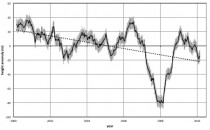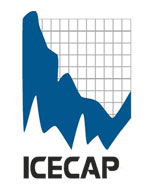By Alan Caruba, Facts Not Fantasy
Full disclosure: Years ago I received a small stipend from The Heartland Institute to help cover the costs of writing articles regarding the global warming hoax, well before it was exposed in 2009 when emails between its perpetrators - the UN’s Intergovernmental Panel on Climate Change - revealed the total lack of real science involved. I have continued to expose the hoax without any support from Heartland or any other entity.
A total of six conferences on climate change have been sponsored by The Heartland Institute. I attended the first conference in New York City in 2008 and my initial observation was that virtually no one from the press was there and the meager coverage it received disparaged it.
This week, a major smear campaign against the Institute erupted as the result of an act of deception and thievery that may well result in criminal charges against its as yet unknown perpetrator.
The President of the Institute, Joe Bast, immediately informed its supporters, directors, donors and friends that someone pretending to be a board member had sent Heartland an email claiming to be a director and asking that documents regarding a January board meeting be re-sent.
A clever ruse, but the result was that elements of the confidential documents were then posted on a number of so-called climate blogs and from there to various members of the media who, with the exception of The Guardian, took no steps whatever to verify the authenticity of the documents, some of which Heartland says were either a concoction of lies or altered to convey inaccurate information.
The leading disseminator of the global warming hoax, The New York Times, published its version on Wednesday, February 15th, titled “Leak Offers Glimpse of Campaign Against Climate Science.”
Suffice to say, the “climate science” served up by the Intergovernmental Panel on Climate Change has been a pack of lies from the day it first convened. Its “science” was based on computer models rigged by co-conspirators that include Michael Mann of Penn State University and Phil Jones of the University of East Anglia.
The original leak of their emails in November 2009 instantly revealed the extent of their efforts to spread the hoax and to suppress any expression of doubt regarding it. A second release in 2011 confirmed what anyone paying any attention already knew.
The “warmists”, a name applied to global warming hoaxers, launched into a paroxysm of denial that has not stopped to this day. Their respective universities have since engaged in every possible way to hide the documentation they claimed supported their claims. Suffice to say, the global warming hoax was the golden goose for everyone who received literally billions in public and private funding.
We have reached the point where the warmists have been claiming that global warming causes global cooling! Along the way the bogus warming has been blamed for thousands of utterly absurd events and trends. What really worried the perpetrators was the fact that the planet had entered a cooling cycle in 1998.
At the heart of the hoax was the claim that carbon dioxide (CO2) was causing the Earth to heat and that CO2 emissions must be reduced to save the Earth. Next to oxygen, CO2 is vital to all life on Earth as it sustains all vegetation which in turn sustains every creature that depends on it as a source of food. It represents a mere 0.033% of the Earth’s atmosphere and is referred to by warmists as a “greenhouse gas.” It is, as any meteorologist or climatologist will tell you, the atmosphere that protects the Earth from becoming a dissociated planet like Mars.
The New York Times article is a case study in bad journalism and bias on a scale for which this failing newspaper is renowned. The Times reported that “Leaked documents suggest that an organization known for attacking climate science is planning a new push to undermine the teaching of global warming in public schools, the latest indication that climate change is becoming part of the nation’s culture wars.”
Wrong, so wrong. Polls have demonstrated that global warming is last on a list of concerns by the public. It barely registers because the public has concluded that it is either a hoax or just not happening. Teaching global warming in the nation’s schools constitutes a crime against the truth and the students.
The Times article makes much of the amounts some donors to Heartland have contributed, but in each cited case, with one exception, the donations had nothing to do with its rebuttal of global warming science.
“It is in fact not a scientific controversy”, said the Times article. :The majority of climate scientists say that emissions generated by human beings are changing the climate and putting the planet at long-term risk, although they are uncertain about the exact magnitude of that risk.”
The exact magnitude is zero. Thousands of scientists have signed petitions denouncing global warming as a hoax. The Times lies.
A post at The Daily Bayonet on February 14th said it well, “What the Heartland documents show is how badly warmists have been beaten by those with a fraction of the resources they’ve enjoyed. Al Gore spent $300 million advertising the global warming hoax. Greenpeace, the WWF (World Wildlife Fund), the Sierra Club, the National Resources Defense Council, NASA, NOAA, the UN and nation states have collectively poured billions into climate research, alternative energies, and propaganda, supported along the way by most of the broadcast and print media.
The Times will continue to publish lies about global warming, as will others like Time and Newsweek magazines. The attacks on Heartland and the many scientists and others like myself who debunk this fraud will continue, but their efforts are just the dying gasp of the greatest hoax of the modern era.
There’s a reason the theme of Heartland’s sixth conference in 2011 was “Restoring the Scientific Method.” Real science does not depend on declaring a “consensus” before the hypothesis has been thoroughly tested, a process that often involves years of effort. Meanwhile, the planet continues to cool.
America’s Green Enemies
By Alan Caruba, Facts Not Fantasy
It was good news that the Nuclear Regulatory Commission approved the nation’s first nuclear power plants on February 9th, clearing the way for the construction of two reactors by Southern Company at its Plant Vogtle site near Atlanta, Georgia. The bad news is that these are the first new nuclear plants since 1978!

In a nation with a growing population and increasing need for electricity to power homes and businesses, it is nothing less than insane to not include nuclear energy in the mix of providers. Environmentalists immediately attacked the announcement using the usual scare campaigns.
Equally insane is the failure to provide the means to safely store the radioactive materials that result. Highly contested by environmentalists, the Nevada-based Yucca Mountain deep geological repository storage facility for spent reactor fuel was cancelled in 2009. Nevada’s Senator Harry Reid, Majority Leader in the Senate, played a major role in this disgraceful decision. The Obama administration terminated funding for the development of the site in 2011, leaving the nation with no long-term storage site.
In a similar fashion, the U.S. Environmental Protection Agency has waged a long war on the provision of energy; most recently with the imposition of its Utility MACT rule on plant carbon dioxide (CO2) and mercury emissions, neither of which pose any threat. Sen. James Inhofe (R-OK), ranking member of the Senate Committee on Environment and Public Works, decried the rule as one “intended to undermine the viability of coal, one of our country’s most abundant and reliable energy sources.”
Despite having spent billions to meet the demand for upgrades of the technology to trap such emissions, coal-fired plants all over the nation are in the process of being closed as a result of the MACT rule. These “greenhouse gas” rules are baseless insofar as CO2 is not a pollutant and is vital to the growth of all vegetation on the planet. There is no proof that minor mercury emissions represent any threat to public health.
The EPA use of bogus “computer models” to support wild health claims argues for an end to this agency and the return of its responsibilities to state environmental agencies.
In January, the American Electric Reliability Corporation (NERC), the leading authority, warned that “environmental regulations are shown to be the number one risk to reliability over the next one to five years.”
The Institute for Energy Research has stated that “Beyond the 38 gigawatts of electricity capacity that has already been announced to retire, NERC estimates that another 36 to 59 gigawatts of capacity will come off-line by 2018, depending on the ‘scope and timing’ of EPA regulations. Together, nearly a quarter of our coal-fired capacity could be off-line by 2018, marking the first time in energy history that installed coal-fired capacity has declined.”
This is a threat to the viability and security of a nation that sits atop the largest deposits of coal in the world! It is a nation in which coal provides 50% of its electricity.
In a similar fashion, environmentalists, after a long propaganda war against coal, have launched an equally massive campaign against natural gas, attacking the use of “fracking’, a technology that has been safely used for the last fifty years or more to access equally vast reserves of natural gas.
Likewise the cost of automobiles has been systematically driven up by the wholly false EPA assertion that their CO2 emissions represent a threat to clean air. The imposition of a mandate to mix gasoline with ethanol has resulted in greater CO2 emissions while, at the same time, reducing the mileage of cars. In addition, the use of food crops like corn for the production of ethanol, have driven up food prices.
Anyone who has lost electricity due to a blizzard or a hurricane knows how totally dependent the nation is on reliable and affordable electricity, and knows how totally dependent they are on is provision.
The simple fact is that the present and prior administration’s EPA, the Department of Transportation, and others have been lying to Congress and the American public for years regarding their claims about air pollution and energy provision. The Interior Department just put uranium-rich acres of land off-limits to mining.
Environmental organizations and special interest groups like the American lung Association are a fifth column of enemies within the nation.
The global warming hoax - now called climate change - is on its last legs. Nations around the world that have wasted billions on the claims made for “renewable” energy, solar and wind, are pulling back from further support. The “science” behind these claims has been totally and utterly refuted.
Even the United Nations, the source of the global warming hoax, is now switching its debased claims to a new hoax based on so-called endangered species.
The loss of tens of thousands of jobs in the energy and transportation sectors, as well as energy-intensive industries, is incalculable. EPA demands and mandates are deliberately undermining the nation’s economy.
The lives and safety of Americans are under attack by environmental organizations and, if they are successful, the only outcome would be the deaths of millions here and around the world from hunger and the lack of power to turn on the lights, heat and cool homes, and power industries.
The planet is not running out of oil, coal, or natural gas. It can use more nuclear power, not less.
Patrick Michaels, Contributor Forbes
People who claim that “the science is settled” on global warming have to be pretty unsettled by the science news in the last week.
“Setttled science”, of course, means that we are inevitably headed toward a disastrous warming of surface temperatures as forecast by some computer models, and we therefore need an international carbon tax or cap-and-trade system, pronto.
Settled science would know all of the important “forcings” and “feedbacks” in the climate system, such as the sensitivity of surface temperature to changes in carbon dioxide (a forcing) and the behavior of clouds, which could either enhance or counter warming (a feedback).
Now it appears that cloud tops are lowering, a totally unforeseen cooling feedback on carbon dioxide-induced warming. Writing in Geophysical Research Letters, University of Auckland’s Roger Davies and Matthew Molloy conclude this could be a “significant measure of a negative cloud feedback to global warming”.
The average global cloud height is linked to the average global temperature - generally, the higher the average cloud height, the higher the average surface temperature, and vice versa. The tie-in is related to the height in the atmosphere from which clouds radiate infrared radiation to space. The higher up they are, the cooler they are, and they dissipate less radiation, which means the surface stays warmer.

Problem is that there’s only ten years of data, and there was a pretty decent La Nina (that’s the cold side of El Nino) in the Pacific Ocean in 2008, which was clearly correlated with a decline in cloud top height. Davies and Molloy are therefore properly cautious with their conclusions, but nonetheless note that a comparison of the beginning and endpoints for their study, which minimizes the La Nina contribution, still showed a decline in cloud height.
Who’d a thunk this one? Based upon data from the paper , the cooling climate impact from the decrease in the average global cloud height more than offset the positive forcing from an increase in greenhouse gases from human activities in the last decade.
This is - yet another - explanation in the refereed literature to apologize for recent climate misbehavior. Others include changes in the sun, cruddy air from China, and a change in stratospheric water vapor.
The last one is especially interesting because that, too, is a previously unknown forcing on climate, i.e. another bullet shot at “settled science”.
Then there’s the new icing on the global warming cake. Data from 2003 through 2010 from the Gravity Recovery and Climate Experiment (GRACE) satellite show virtually zero net melting from the massive Himalayan ice cap, the world’s “third pole”. The UN, using an unrefereed publication from the World Wildlife Federation, erroneously forecast in its last climate compendium that it would be gone by 2035. In reality, it will last hundreds of years, and even longer if the current trends reflect how the ice cap reacts to warming.
How could prominent glaciologists like Ohio State’s Lonnie Thompson, who isn’t shy about predicting glacial armageddon (and, who along with his wife, advises Al Gore on matters climatic), have missed this one? Simple - who wants to climb to the top of a Himalayan glacier? That can be close to the oxygen-starved “dead zone” where humans cannot linger. So most measurements have been made from the bottom. It shouldn’t surprise anyone that the top of these behemoths will expand in a warmer world, as the ocean evaporates more moisture which will surely precipitate as snow at higher elevations.
In addition, the GRACE satellite found that total ice loss outside of Greenland and Antarctica was previously estimated 30% too high, another reinforcement of the “lukewarm” synthesis of climate change. After adding in the GRACE measurements for Greenland and Antarctica and median estimates for the “thermal expansion” of water, the current rate of sea-level rise is 8 inches per century. While that surely will rise before 2100, it’s only one inch more than what was observed last century.
What with the finding of yet another cooling feedback, no net melting (within the range of measurement error) in the Himalayan ice cap, and confirmation of a low rate of sea level rise, it’s been a bad week for climate hotheads.
-------------
Also see self annointed scientist Tamino get the beat down AGAIN here and http://wattsupwiththat.com/2012/01/31/part-2-of-tamino-once-again-misleads-his-disciples/ for faulty science.
Foreword to Andrew Montford’s Nullius in Verba: The Royal Society and Climate Change
Andrew Montford provides a straightforward and unembellished chronology of the perversion not only of The Royal Society but of science itself, wherein the legitimate role of science as a powerful mode of inquiry is replaced by the pretence of science to a position of political authority.
The simple chronology speaks for itself, though one cannot read it without thinking, at least, about the motivations. Already in the 19th century, gentleman scientists, like Darwin, noted the potential constraints on scientific inquiry that were associated with functioning within universities. The potential in recent years is obviously magnified by the near monopoly over science support exercised by governments. In the US, our National Academy of Science (NAS) has always had official status as adviser to the government. However, the role was relatively passive until the 1970s.
The 1970s saw a marked expansion of the National Research Council, the branch of the National Academy of Science responsible for responding to government requests. With the presidency of Frank Press (1981-1993), the staff of the NRC increased to over a thousand. Frank often boasted that The Royal Society was envious of the position of the NAS and the existence of its NRC. The global warming issue, it would appear, has offered The Royal Society the opportunity to rectify this situation.
Nevertheless, there are certain peculiarities of The Royal Society’s behavior that are perhaps worth noting. The presidents involved with this issue (May, Rees and Nurse) are all profoundly ignorant of climate science. Their alleged authority stems from their positions in the RS rather than from scientific expertise. This is evident in a variety of ways.
For example, in an exchange in the Financial Times (April 9, 2010), Martin Rees and Ralph Cicerone (President of the NAS) defended global warming concern by noting essentially that carbon dioxide (CO2) was increasing and that climate was changing. Of course, climate is always changing, and increasing CO2 must make some contribution, but none of this suggests anything alarming.
The alarm results from controversial feedbacks wherein the small impacts of CO2 are, in current computer models, greatly amplified. With respect to these feedbacks, Rees and Cicerone say: “Uncertainties in the future rate of this rise (referring to global mean temperature anomaly), stemming largely from ‘feedback’ effects on water vapor and clouds are topics of current research.”
That is to say, we don’t even know if there is a problem. Yet, Rees and Cicerone conclude: “Our academies will provide the scientific backdrop for the political and business leaders who must create effective policies to steer the world toward a low-carbon economy.”
In other words, regardless of the science, the answer is predetermined. Is this simply ignorance or dishonesty? My guess is that Rees and Cicerone were only mindlessly repeating a script prepared by the environmental movement.
In this report Montford documents some disturbing general trends, which one can only hope that scientists of good standing shall increasingly continue to oppose.
Professor Richard Lindzen
Richard Lindzen is the Alfred P. Sloan Professor of Meteorology at the Massachusetts Institute of Technology and a member of the Academic Advisory Council of the Global Warming Policy Foundation. He is known for his work on the dynamics of the middle atmosphere, atmospheric tides and ozone photochemistry. He has published more than 200 books and scientific papers.


